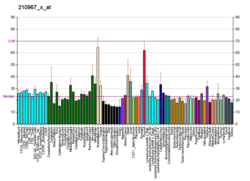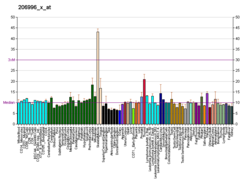Voltage-dependent L-type calcium channel subunit beta-1 is a protein that in humans is encoded by the CACNB1 gene. [5] [6] [7]
Contents
The protein encoded by this gene belongs to the calcium channel beta subunit family. It plays an important role in the calcium channel by modulating G protein inhibition, increasing peak calcium current, controlling the alpha-1 subunit membrane targeting and shifting the voltage dependence of activation and inactivation. Alternative splicing occurs at this locus and three transcript variants encoding three distinct isoforms have been identified. [7]
Mutations in CACNB1 are known to cause the following conditions: Malignant Hyperthermia; Congenital Myopathy; Alzheimer's Disease; Autism Spectrum Disorder. [8]









